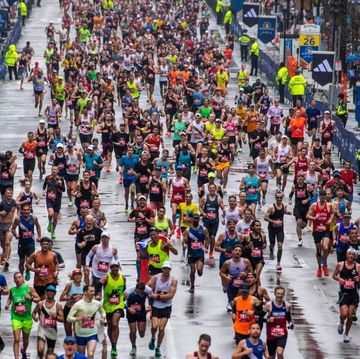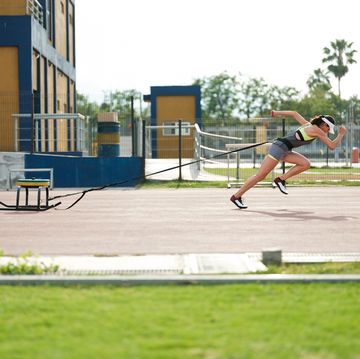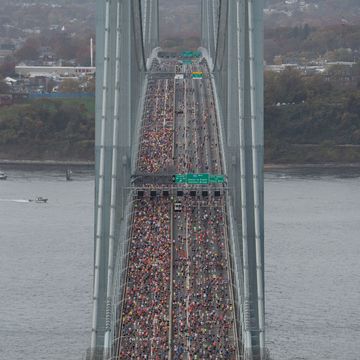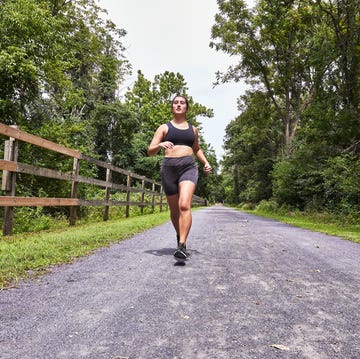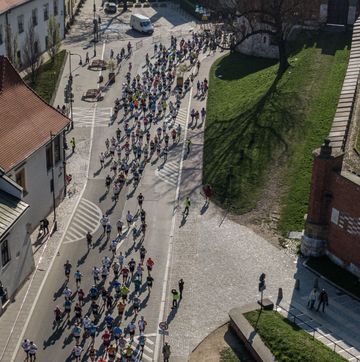When Gabriele Grunewald kicked past Jordan Hasay at this year's USA Track & Field 3,000m indoor championship in Albuquerque, N.M., everyone watching presumed Grunewald had sealed her first trip to the world championships. But in her wake, an umpire held an upraised yellow flag: a $10 rectangle of colored fabric, signifying a foul, which was to unleash one of the biggest firestorms in recent track history.
Normally, the process would be for the umpire to consult with the head referee, who is the official charged with issuing on-the-field rulings. Anyone who disagrees then has the right to protest--a procedure that serves roughly the same function as the National Football League's instant-replay process. But the NFL produces final decisions within minutes. USATF's process can drag on for hours.
Stripped of complexities, what happened was this: The umpire saw contact as Grunewald passed Hasay, but the referee decided there had been no infraction. Hasay's team protested--and lost. Hasay's team appealed--and again lost. At that point, USATF procedures say the decision should have stood. But Hasay's team appealed again--and, hours after the race, the contact was ruled a foul. Grunewald was disqualified.
Under USATF rules, such reconsiderations are allowed, but only if new conclusive evidence is presented." In press releases, USATF referred to enlarged digital images but did not specify who produced them or if they were truly new. Whatever the evidence was, it has not been released to the public. When questioned in March about the incident, USATF spokesperson Jill Geer told Running Times, "Comments related to Albuquerque have already been made and are cited in our various comments, statements and releases from Albuquerque."
Grunewald's team then called foul. She is sponsored by Brooks. Hasay's team is funded by Nike. Nike is listed as an official sponsor of USATF, and according to tax filings, sponsorships account for $10.5 million of USATF's $22 million budget. In the eyes of observers, USATF ignored its protest rules to benefit its contributor's runner.
Two days later, Hasay announced that she did not want to go to worlds "this way" and withdrew her protest. An hour later, USATF reinstated Grunewald: an irony because there is no rule that clearly allows that, either. While Grunewald took her spot on the team bound for Poland, many questions remain from the weekend. In the men's 3,000m, Andrew Bumbalough was disqualified for contact with Galen Rupp, when a video of the race shows Ryan Hill, in the same uniform as Bumbalough, stepping in front of Rupp. Bumbalough's agent says USATF has not responded to his queries about the ruling.
The meet in Albuquerque was not the first time USATF has been embroiled in controversy, though it might be the most public, thanks to online reporting and social media. Over the years, there have been a string of similar controversies:
Houston vs. Los Angeles for the 2016 Olympic marathon trials
Here, USATF created a committee to review competing bids to host the 2016 trials, with its findings to be reported during USATF's December 2013 annual meeting. Three cities weighed in: Houston, Los Angeles and Cincinnati, with the committee picking Houston. Many observers were expecting the final decision to be announced at the meeting, but instead it didn't happen for another two months, at which time USATF overruled the committee to pick LA. Despite the outcry from some sectors, this wasn't a breach of procedure. "There was no scheduled announcement," Geer says. In fact, she notes, in 2012, the location of the Olympic trials wasn't announced until May, "so we were actually ahead of that time frame." Furthermore, she says, the committee's job was limited to evaluating the competing bids from the athletes' perspective, while the final choice took other factors, like media exposure, into account. "In the end, LA presented the best opportunity for our athletes, the trials and the sport," she says.
2013 men's 5,000m national championship
This time, rather than bending its rules, USATF scrupulously adhered to them to prohibit late entries, even though scratches had reduced the field to nine and other qualified runners were ready to go. "It was disappointing because there were a lot of good athletes who wanted to run and didn't have the opportunity," says Dan Lilot, a Mountain View, Calif., agent who represents many distance runners. Furthermore, he says, it was obvious that there would be scratches from the 5K field. "Anyone who looked at the accepted entries could tell that something like two-thirds of that field were also entered in the 10,000 or the 1500," he says. "I had two guys [Dathan Ritzenhein and Chris Derrick] who had a good chance to make the team at 10K, and I told USATF that if these guys made the team, they were not going to run the 5K."
2012 Olympic trials 100m
At the 2012 Olympic trials, Allyson Felix and Jeneba Tarmoh raced to a photo finish in the 100m finals, tied for third, and only three can make the team. It was an unprecedented event, and USATF had no rule to break the tie. That itself was embarrassing. Worse was the fact that even while the photo finish was under review, Tarmoh found herself declared the winner and given a victory lap, flag and press conference--only to discover via a reporter's question in the middle of the press conference that she might not have made the team.
2011 club cross country championships
In October, only weeks before the December meet, USATF announced that competitors would be required to abide by professional-level rules on uniform logos--rules that would ban all but a handful of the nation's club uniforms. Not only were clubs infuriated, but Seattle's Club Northwest, which was hosting the event, stood to lose thousands of dollars if teams with noncomplying logos were excluded. The ruling was unexpected. "I specifically asked national staff members about this [in] February," says Becca Gillespy Peter, Club Northwest's manager, "and was told that this rule would not be applied to our meet. We learned of it when it appeared on the [USATF] website." One week before the meet, the rule was rescinded.
2008 Olympic trials 10,000m
Contrary to the 2013 5,000m, where no late entries were allowed, Adam Goucher was permitted to enter the field late, even though USATF rules limit the number of competitors in a single-section 10,000m to 24 and Goucher's qualifying time was slower than that of many who'd been excluded. "They just added [him] and skipped over the others," says Jonathan Little, an Indianapolis sports lawyer who adds that "Gouchered in" has subsequently become a way of describing situations in which one runner leapfrogs into a race ahead of another. At the time, USATF countered that the goal was to produce the best possible field. (Goucher finished seventh, with a lifetime PR.) "He is a five-time USA champion," the organization said in a 2008 press release. "It is not unusual for past national champions . . . to be granted entry into national championship events."
1996 Olympic trials 10,000m
In this race, the reverse happened, with Coloradan Shannon Butler denied entry, even though he had a faster qualifying standard than several who were allowed to run. "He was arbitrarily excluded," says Little, who notes that Butler later sued USATF, winning an unknown sum.
Given this history, it's not surprising that the Grunewald controversy produced a wave of anger. "This has been going on since the '80s--this whimsical enforcement of the rules," Little says. "They've made a lot of mistakes but keep making the same ones over and over."
Paul Doyle, Grunewald's agent, concurs. "There has been a history of suspicious occurrences at U.S. championships," he says. "It goes way beyond protests and disqualifications. USATF often doesn't seem to follow their own rules."
One problem is that much of the work at track meets is done by volunteers. These people are dedicated, says Paul Greer, who sits on two USATF national committees and has twice served as co-director of national-championship meets. But sometimes volunteers can let things slip, he says, or make decisions that are "not entirely thought through."
Little agrees. "You have people just kind of winging it," he says.
Adding to the problem, Little believes, are the 1978-79 reforms that divvied up the governance of Olympic sports from the Amateur Athletic Union to a slew of national governing bodies (NGBs). The goal was to change a system that had come under fire from track and field athletes for arbitrary rules and draconian restrictions on athletes' opportunities to make money. According to Little, the change was only partially successful, replacing one monolithic agency with 49 smaller ones whose rules remained arbitrary. "I do a lot of work with NGB s," he says. "They're all bad." In fact, he notes, USATF's controversies are "relatively minor" compared to such problems as sports that simply name national teams by decree. "Compared to them, we're doing pretty well," he says.
Adam Nelson, an Olympic gold-medal winner in the shot put who is now president of the 5-year-old Track and Field Athletes Association (TFAA), adds that part of the issue is that sports have become increasingly commercialized since the NGBs were established as nonprofit organizations. To fill budget gaps, NGBs have turned to commercial sponsors: mostly shoe companies in the case of track and field. But in the course of finding corporate sponsorship, Nelson says, "ideals can get lost," including "the notion that the athlete is always first."
At press time, Brooks, Saucony and Oiselle had agreed to support TFAA should it call on athletes to boycott USATF events. Another solution, Nelson believes, is to increase the voice of athletes in important decisions, beginning with rules decisions. His organization has proposed that independent athletes' representatives be present as observers at appeals processes in major meets--something he thinks could offset the appearance of impropriety. "The only way is to add an element of transparency and neutrality to the system," he says. In a March 26 statement, USATF president and chairman Stephanie Hightower replies: "There has been public discussion the last several weeks about a range of topics in our sport, centered around field-of-play decisions made at the USA Indoor Championships. As we have stated, USATF is taking a look at the events of Albuquerque as well as our related systems and processes. Public suggestions to the contrary, the topics related to Albuquerque are not quick fixes. These are topics that involve important elements of our structure that have ramifications far beyond race results at a single meet."
It would also help, athletes and agents say, if USATF would be more open in explaining how decisions such as the ones involving Grunewald are made. "As someone who sits on the committees," Greer says, "I would like to see clear communication from the upper leadership that just says we were wrong, or clearly explains what happened. The less they say, the more it comes across as a cover-up."
READING THE RULE BOOK
The guideline that sparked the Grunewald controversy is 163(4) in the USATF rule book, which states: "Any competitor or participant jostling, running across, or obstructing another competitor or participant so as to impede his or her progress shall be liable to disqualification in that event."
The idea is simple. But what does "so as" mean? With the effect of? With the intent to? Or something in the middle?
"I've never seen a statute use 'so as' in this manner," says Anne Nguyen, a marathoner and lawyer in Portland, Ore.
The National Football League's rule book begins with 11 pages of definitions. A word search of the USATF rule book produces only 16 uses of the word definition, mostly related to race walking, drug testing, relay teams and age divisions. Prominently missing are definitions of such terms as impede or so as to impede.
"Defining terms won't prevent every dispute, but it could certainly give more guidance," says Laura Cadiz, another lawyer and distance runner in Portland, Ore. "The more specific the definition, the better."






